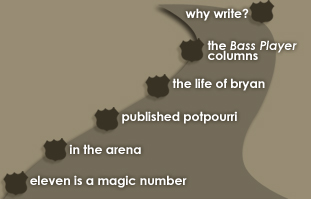
 |
|||||||||
|
|
|||||||||
| Sign up for BellerBytes, the official (and private) Bryan Beller e-newsletter. Just click here to sign up. Do it, OK? | |||||||||
|
Billy
Sheehan Interview It's a scenario that's probably played out a thousand times. A professional musician traveling through San Diego knows someone at the Taylor factory and wants to take the tour. Once inside the facilities, the artist eyes a certain guitar that he just can't leave behind; it has to go home with him. A couple of years ago, that happened to Billy Sheehan. Sheehan, the monster-chops electric bassist who has been voted "Best Bass Player" five times in the annual Guitar Player reader's poll, the world-famous former sideman for David Lee Roth, the bassist for multi-platinum rock band, Mr. Big, wanted--no, demanded--a Taylor acoustic guitar. An 855 12-string, no less. "[Taylor Director of Human Resources] Suzanne Peña is a friend of mine, and she invited me down to the factory to check it out, walk around," Sheehan said in a recent conversation. "I'm a sucker for 12-string guitars. I love them. They showed me that 855 12-string, and I got miffed right away, because there was no way I was going to leave without it." Sheehan's very own hunk of wood and steel isn't just a showpiece sitting on the wall of his Los Angeles townhouse. He used it to record two tracks--"New Religion" and "Rose Alone"--on Mr. Big's first studio release in four years, Get Over It (Atlantic Records). And he's had a longer and more fruitful history with the acoustic guitar than one might expect. "I've written on acoustic guitar since I began playing, and rhythm-picking is a real natural thing for me to do, but I never really utilized it within the band," he said. "So now, being able to do it is kind of cool. The Taylor sounded so great, it's just automatic. There's no pain in putting it to tape, or to disc, as we do now. Just sit with it in front of a great mic and it sounds wonderful." Sheehan's been a busy man for some time, but his current schedule is in studio hyperdrive. He's simultaneously writing and recording for three projects: the next Mr. Big record, his "bluesion" project Niacin (with John Novello on Hammond B3 and the mighty Dennis Chambers on drums), and two solo albums--one with vocals and one without. "In case you don't want to hear my voice you'll have a choice," he reasons, laughing. "[But] I sang lead before in a band, live. I sang the [David] Bowie and the Judas Priest stuff." Make no mistake, though--bass remains his calling. With a signature model Yamaha electric bass to his name, he has a fairly good idea of what he wants and expects out of an instrument. Then, he came across the Taylor AB-1 acoustic bass. Though he now sees it as "an inspirational tool" that he plans to use on his upcoming solo albums, at first it threw the master craftsman for a bit of a technique loop. But not for long, and according to him, he enjoyed the ride. "As a player, I like to be challenged and forced into a corner, and have to figure a way out of it. So, when [Taylor] came to me with the idea of doing a track on the third Sounds of Wood&Steel record [due next summer], I was excited about it. I got the bass, and, honestly, I started to have second thoughts. I thought, 'Gee, I don't know if I can play this beast!' So, I tweaked around a little bit, changed the action, and sure enough, as I played it I really did fall in love with it. We did the track, [and] the piece that came out of it kind of wrote itself. It's a drone-y, Indian-style thing called 'Bombay Doors'." Sheehan's busy clinic schedule recently took him to South America, only fitting since he uses various flamenco techniques usually reserved for more traditional acoustic guitarists. Though he never formally studied the method, he freely admits to "steal[ing] everything I'm capable of stealing" from the Gypsy Kings and flamenco legend Paco de Lucia. "It was interesting," Sheehan said, "that flamenco stuff, on this bass [the AB-1], because the chordal stuff is really nice. It's really cool to be able to do intervals you wouldn't normally do on an electric bass, because they translate more like a guitar would." Back in the electric world, the power trio Niacin provides Sheehan with plenty of room for his growling, overdriven bass tone. Their latest record, Deep (Magna Carta), is best described as an instrumental assault featuring equal parts, rock, funk, blues and fusion. Sheehan's been accustomed to virtuosic musical aggression at center-stage since the days of his first band, upstate New York's Talas. But in Niacin the improvisational factor is much higher. Communication is key, especially with a drummer like Dennis Chambers behind the kit. "It's a blast to play with them live," Sheehan explains. "We did some shows in the U.S., a lot of shows in Japan, and we even went to Indonesia with it. When we got done with a week in Indonesia, by the last show we were way out. It was so improvisational that it was anybody's guess where anything was gonna go. Things were happening real automatic. Dennis would make a left turn, and it just so happened to be the left turn that I made. End up down the same street, you know? For me, that's the real magic of playing together with somebody in improvisational music. You really get to the point where you're thinking alike." According to Sheehan, when it comes to starting out on an instrument, there's no substitute for real playing experience, and it's never too soon to start. While that may strike some as self-evident, he speaks to a phenomenon all too familiar among young players eager for lessons in the latest Music Theory, as if music--and rock music in particular--is a strictly academic concept. "I have to keep explaining over and over again that I played first and I figured it out later. I came up with the technique because I needed those notes in that song for that show, and later on I figured out where my thumb was positioned, or which finger was doing what." He sits back and ponders for a second before continuing. "Not every musician has the luxury nowadays of playing live, like we used to back in the 70's. We did 21 shows in a row once. Three shows in one day. Complete, separate shows--set up, play, tear down--three in one day! You really learn so much about performing. You also learn what works to keep people on the dance floor, keep them in the bar, keep them drinking so the bar owner will hire you back." Thankfully for Sheehan, those days are over. Whether it's with Niacin, Mr. Big, or on his solo projects, he's got the best of both worlds going for him: financial success and artistic freedom. His hard-earned good fortune doesn't go unnoticed. "A lot of artists get in a situation where they're forced into doing something they don't really love. It's going to be playing no matter what you're playing, that's my theory, but I just consider myself really lucky. This sounds cliché, but my life does revolve around my music. It's all I do, really. Playing bass, there's not much else I do." Except for those times when he reaches for the instrument he just couldn't leave behind. This copyrighted article first appeared in the Winter 2001 issue of Taylor Guitars' quarterly publication, Wood&Steel. It is reproduced here by permission of Taylor Guitars for the sole discretionary use of Bryan Beller and cannot be reproduced or reprinted anywhere else without the express permission and consent of Taylor Guitars |

|